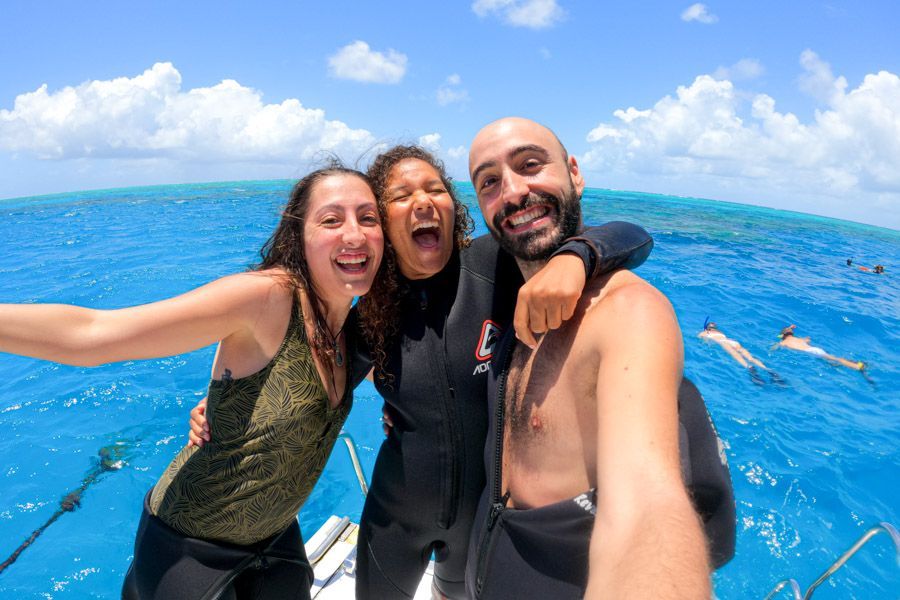Can You Swim In The Ocean In Cairns?
Tropical Far North Queensland may be home to some of the deadliest animals in the world, which may get you wondering...can you swim in the ocean in Cairns? Of course you can! Your main concerns when taking a dip in the Cairns ocean are stingrays and jellyfish. That’s not to say saltwater crocodiles don’t pose a threat on the beaches as well, however, they tend to prefer the muddy and brackish waters of estuaries and creeks.
Here are some helpful travel tips for swimming safely in Cairns!

Where Can You Swim In The Ocean In Cairns?
The best beaches for swimming near Cairns are Trinity Beach, Palm Cove, Ellis Beach and Holloways Beach. All four of these sandy tropical oases are patrolled year-round and are protected by stinger nets in the summer season (November to March/April). Crocodiles typically don’t pose a threat on these beaches, however, that shouldn’t stop visitors from exercising extreme caution and keeping croc-wise when on Croc Country.
Avoid swimming in the early mornings and late afternoons and opt for a pool swim when the beach water is stilty and unclear — remember, crocs love hiding in brackish water. In the event of a croc sighting at any of these beaches, the local surf life saving club will erect warning signage for 72 hours, wherein it’s strongly advised to abstain from swimming.
And for all the daredevils dying to get up close and personal with the pearly whites of a saltie (couldn’t be me!), plunge into croc-infested waters at Wildlife Habitat’s CrocArena! This is the only way we’d recommend catching a closer look at these prehistoric beauties.
Swim safely around Cairns on these tours!
Do You Need a Stinger Suit in Cairns?
Stinger suits are highly recommended between the months of November to April, even when swimming in netted areas. If you’re out on the Great Barrier Reef, most tour operators will provide suits for free or a small additional fee — and it’s totally worth it for peace of mind, plus they help to protect your skin from the harsh glare of the Far North Queensand sun!

What kinds of jellyfish are in Cairns?
The two kinds of jellyfish you need to be worried about in Cairns waters are the Irukandji and its big cousin, the box jellyfish. Both species are in the box family, with the former being the smallest in the family and the latter being the largest. Despite being the largest, the box jellyfish is still incredibly difficult to spot in the water, thanks to its translucent skin. On the other end of the size spectrum, Irukandji are also near impossible to spot, measuring between 12 to 30 millimetres.
Aside from always donning the daggy stinger suit, the best way to identify a possible incoming of Irukandji at the beach is an increase in sea lice and shorelines excessively marooned with salps — those see-through jelly-like blobs that children like to play with — as they make tasty snacks for the lethal Irukandji.

Other Safe Places to Swim in Cairns
In addition to the beaches that have stinger nets and lifeguards, there are plenty of other options for swimming safely in Cairns. In the unlikely event that all of Cairns local beaches are unavailable for swimming, the Cairns Esplanade Lagoon is always a safe option for a stinger and croc-free splash.
There are also multitudes of safe waterfalls and watering holes less than an hour from Cairns! Head to the rainforest outside the city for a refreshing splash in a freshwater waterfall or swimming hole. If you're unsure of where to go, you can book a guided waterfall tour. Or rent a car and take a day trip. Either way, there are lots of places to escape the heat in Cairns.

What time of year is it safe to swim in Cairns?
It's safe to swim in Cairns year-round if you follow the precautions we've mentioned! But if you want to swim without a stinger suit, it's safe in the oceans between the months of June and October.
Despite the crocs, stingers and stingrays who call Cairns home, swimming in North Queensland can still be safe — given that you exercise all of the relevant safety measurements.
Always wear a stinger suit, swim in netted and patrolled beaches between the red and yellow flags, and stay croc-wise!















